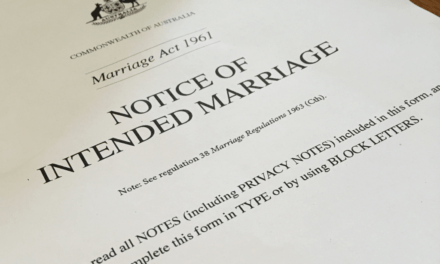It is a legal requirement that couples who want to get married in Australia give at least one month’s, and no more than 18 months’, notice through lodging a Notice of Intended Marriage with an Authorised Celebrant. However in some exceptional circumstances it is possible to have that notice period shortened by applying to a prescribed authority for a Shortening of Time. In capital cities prescribed authorities can generally be found at the Registry of Births, Deaths and Marriages; for regional and rural areas the list of prescribed authorities should be consulted.
Making such an application is the couple’s responsibility, but there are some things the celebrant needs to do to support the application.
First you need to understand the reasons a couple may apply for a shortening of time. The following categories cover the ONLY circumstances in which a shortening of time may be granted:
- employment related or other travel commitments
- wedding or celebration arrangements, or religious considerations
- medical reasons
- legal proceedings, or
- an error in giving notice.
Further information about the applicable circumstances that may fall under each category and the types of evidence a prescribed authority will want to see can be found in Schedule 3 of the Marriage Regulations 2017, and I have included them at the bottom of this post.
The celebrant should explain to the couple that:
- the reason for seeking a shortening MUST fall within one of the categories described above
- a prescribed authority has NO DISCRETION to grant a shortening outside the circumstances covered by these categories
- a shortening of time is not automatically granted
- a prescribed authority may charge an application fee.
The celebrant should advise the couple to:
- complete an application form for a shortening of time (if required by the prescribed authority; e.g. in Victoria an application form is required but not in Queensland)
- make an appointment with the prescribed authority
- gather any and all documentary evidence relating to their circumstances.
The celebrant should provide the couple with:
- a letter of support, noting that they believe the couple’s circumstances may fall under one of the appropriate categories, and that they will be available to marry the couple at the date and venue selected if the shortening of time is approved (you can download my template by scrolling to the bottom of this post)
- the original, completed Notice of Intended Marriage (this is the ONLY circumstance in which the celebrant should release the original NOIM to the parties).
Every state has its own way of dealing with shortening of time applications, and different timelines for considering applications. In Victoria, they generally consider medical reasons applications on the spot, and all other applications take 48 hours.
If the shortening is granted, the original Notice of Intended Marriage will be stamped by the prescribed authority and the date of the proposed wedding noted in the stamp. The NOIM will either be returned to the couple to return to the celebrant, or posted directly to the celebrant.
Shortenings are definitely not scary and I’ve had plenty of couples who have received permission to shorten the notice period. Just make sure you follow the process and don’t give advice outside your remit (i.e. don’t tell a couple their shortening will definitley be granted; it can depend on the person they get on the counter at BDM on the day they apply), and all will be grand!
Legal stuff
The requirement for couples to give at least one month’s notice to marry is outlined in section 42(1)(a) of the Marriage Act 1961 and further discussed starting at page 33 of the Guidelines on the Marriage Act for Marriage Celebrants 2014.
The ability to shorten the notice period is provided in section 42(5) of the Marriage Act 1961. The circumstances under which the notice period can be shortened are outlined in Schedule 3 of the Marriage Regulations 2017. The process for a Shortening of Time is discussed on pages 23-25 of the Guidelines on the Marriage Act for Marriage Celebrants 2018.
Marriage Regulations 2017, Schedule 3 – Circumstances for authorising marriage despite late notice
1 Employment‑related or other travel commitments
1) A circumstance is that the marriage should be solemnized despite the required notice not having been received in time because a party to the intended marriage or someone involved with the proposed wedding:
- has employment commitments that necessitate the person’s absence from the location of the proposed wedding for a considerable period of time; or
- has other travel commitments.
Examples
- A party to the intended marriage has accepted an offer of employment for imminent transfer or posting overseas or to a part of Australia distant from the location of the proposed wedding for at least 3 months, and wishes to be married with the party’s family and friends present before the departure.
- A party to the intended marriage realises that a close relative or friend of the party is in Australia but the relative or friend has a non‑redeemable ticket for departure from Australia within less than a month, and the party wishes the relative or friend to be present at the wedding.
2) In determining whether the circumstance in subclause (1) is met, the prescribed authority may take into account the following:
- documents relating to the employment commitments such as a letter of offer and a letter of acceptance;
- documents relating to the travel such as a dated receipt or a ticket;
- any explanation provided for not giving the notice sooner;
- any explanation provided for not postponing the proposed wedding;
- whether hardship would be caused to a party to the intended marriage if the marriage is not solemnized as proposed;
- any other matter that the prescribed authority considers relevant.
2 Wedding or celebration arrangements
1) A circumstance is that the marriage should be solemnized despite the required notice not having been received in time because of the binding nature of the wedding arrangements or celebration arrangements made in connection with the intended marriage, or because of any religious consideration.
Example
Arrangements and non-refundable payments of a considerable sum have been made for the proposed wedding, or for any celebration associated with the intended marriage, and the date for the wedding or celebration cannot be changed.
2) In determining whether the circumstance in subclause (1) is met, the prescribed authority may take into account the following:
- documents showing the extent of preparations for the proposed wedding, such as receipts showing dates and amounts of payments connected with the wedding;
- in the case of a religious consideration–the nature of the consideration;
- any explanation provided for not giving the notice sooner;
- any explanation provided for not postponing the proposed wedding;
- whether hardship would be caused to a party to the intended marriage if the marriage is not solemnized as proposed;
- any other matter that the prescribed authority considers relevant.
3 Medical reasons
1) A circumstance is that the marriage should be solemnized despite the required notice not having been received in time because a party to the intended marriage, or someone involved with the proposed wedding, is suffering from a medical condition of a serious nature.
Example
A party to the intended marriage, or a parent or close relative of the party, has a serious illness that will prevent the person from attending the wedding unless it is held in less than a month.
2) In determining whether the circumstance in subclause (1) is met, the prescribed authority may take into account the following:
- a letter from a medical practitioner or other health professional confirming the relevant health circumstances;
- any explanation provided for not giving the notice sooner;
- any other matter that the prescribed authority considers relevant.
4 Legal proceedings
1) A circumstance is that the marriage should be solemnized despite the required notice not having been received in time because a party to the intended marriage is involved in a legal proceeding.
Example
A party to the intended marriage is subject to a pending court proceeding, and is at risk of imprisonment.
2) In determining whether the circumstance in subclause (1) is met, the prescribed authority may take into account the following:
- a sealed copy of any applicable court order;
- a letter from the party’s solicitor stating the dates and nature of a pending court proceeding;
- any explanation provided for not giving the notice sooner;
- any explanation provided for not postponing the proposed wedding;
- whether hardship would be caused to a party to the intended marriage if the marriage is not solemnized as proposed;
- any other matter that the prescribed authority considers relevant.
5 Error in giving notice
1) A circumstance is that the marriage should be solemnized despite the required notice not having been received in time because:
- it was due only to error on the part of an authorized celebrant (or a person whom the parties to the intended marriage believed to be an authorized celebrant) that the required notice was not given or that the notice given was invalid, stale or lost; and
- arrangements have been made for the proposed wedding to take place within the one month period.
Examples:
- The parties have given significant notice to the authorized celebrant orally, and arrangements for the proposed wedding have been made, but written notice was not given in the required time because the authorized celebrant failed to explain the notice requirements properly.
- The parties have given written notice in the required time, and arrangements for the proposed wedding have been made, but the notice is invalid because the person to whom the notice was given was not yet registered as a marriage celebrant.
- The parties have given written notice in the required time, and arrangements for celebrations have been made to follow the marriage ceremony, but the notice was lost by the authorized celebrant.
2) In determining whether the circumstance in subclause (1) is met, the prescribed authority may take into account the following:
- documents confirming why the notice was not given, such as a letter confirming an earlier interview with the parties to the intended marriage;
- a letter from the person to whom the notice was given explaining why the notice was invalid, stale or lost;
- documents showing the arrangements made in connection with the proposed wedding;
- any other matter that the prescribed authority considers relevant.





